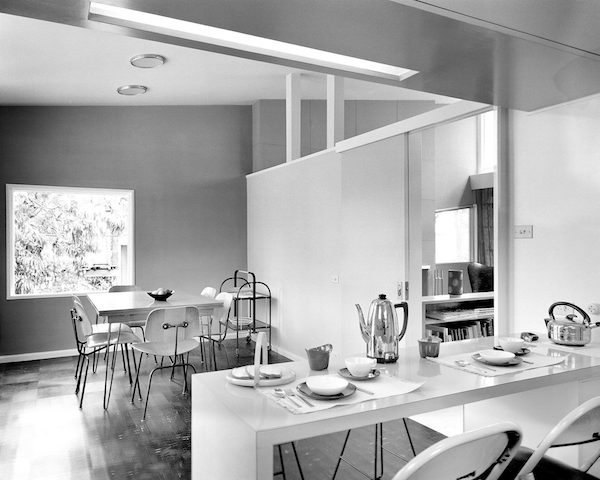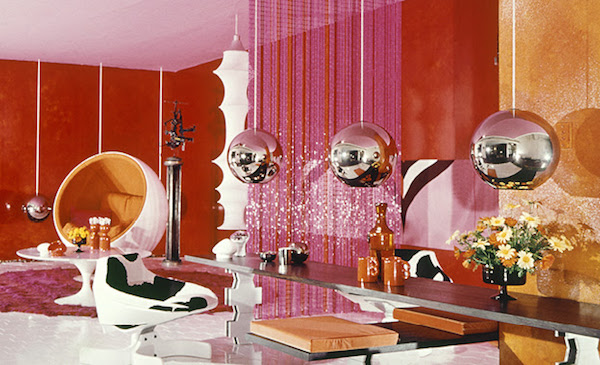Detail of staircase in Buhrich House, Castlecrag, 1958. © Max Dupain Archive, State Library of NSW. Courtesy JWThompson.
Is good design never forgotten? While the desired answer would be no, a new exhibition at the Museum of Sydney demonstrates that, sadly, even the best designers and architects can slip from popular memory, despite shaping the vision of a modern city.
The Moderns: European Designers in Sydney takes a look at the dynamic community of émigré architects, interior designers and furniture makers who arrived in Sydney during the 1930s to 1950s; highly qualified, highly respected professionals who were often encumbered by their qualifications not being recognised in Australia.
That, however, did not stop them.
Designer George Korody (formerly a professor in Hungary) founded the premier retailer of European-designed furniture in Sydney, Artes Studio, while German architecture graduate Eva Buhrich, despite having studied at esteemed European universities in Berlin and Zurich, became a prominent architectural commentator.
Guest Curator of The Moderns, Rebecca Hawcroft explained: ‘Eva Buhrich was an interesting character in this landscape of designers in Sydney. She wrote a regular column in the Sydney Morning Herald (from 1957 to 1968) and even published designs for readers to make their own bespoke modern furniture in Australian House and Garden.’
Learn about the other designers in The Moderns.
Hawcroft has been researching these “lost moderns” for a decade prior to curating this illuminating original exhibition.
It is a little like finding lost treasure. She told ArtsHub: ‘This exhibition is both a social and design history and an acknowledgement of their substantial achievements.’

Hawcroft has designed the exhibition so that each room is like a complete, curated time capsule. Visitors can walk into an object-rich space that tells the stories of these émigré architects, interior designers and furniture makers working through the 1940s to 1960s.
‘It was not about furniture on pedestals; it was about creating a story of how this all connected, and we had Max Dupain’s fantastic archive of images of this circle and its designs,’ she said.
Viewers are introduced to the likes of cabinetmakers Michael Gerstl and Paul Kafka, who brought a European flavour to the custom-made furniture market; Steven Kalmar, whose lightweight furniture was a staple for the modern home; architects Henry Epstein and Hugh Buhrich, who designed starkly modernist houses in Sydney from the 1940s, and Hugo Stossel and Hans Peter Oser, who both formed large firms that helped transformed Sydney’s skyline.
The Moderns takes viewers on a stroll back through that forgotten history. How did these celebrated professionals come to be in Sydney? What is the story of their achievements and how did they adapt their careers?
 Max Dupain Archives.png)
Frisco furniture store, 1963. © Max Dupain Archives, State Library of NSW.
Hawcroft said the exhibition was timely, not only from the perspective of a renewed appreciation for 20th century design and the bespoke or handmade, but as a pertinent picture of what refugees can contribute to a nation.
She said: ‘George Korody came here in his fifties from Hungary. While he was well known for Artes Studio, which all the designers went to – it was the place for modern furniture – nothing was known of his achievements before coming to Australia. He was actually a design teacher in Budapest taking the title of Professor, and had completed a number of significant and well-known projects in Budapest. A number of his furniture pieces are held in the collection of the Hungarian Applied Arts Museum’
Korody went on to become the founding member of the Society of Interior Designers of Australia, while Eva and Hugh Buhrich both played a key role in advocating for preventing the demolition of the Walter Burley Griffin-designed Willoughby Incinerator in 1975.
Their second house, Buhrich House II, designed and built by Hugh in 1968–72, is widely acclaimed as one of the finest examples of modern architecture in Australia.
When we think of modernist European designers in Sydney, the quick reference point is the Opera House’s Jørn Uzton and Austrian-born Harry Seidler AC OBE, whose buildings dot Sydney’s skyline.
This exhibition shows that Seidler was singled out in the popular view from amongst a large, robust and interconnected community of European designers who were his contemporaries.
The exhibition shows that this urban, middle class community of creatives were a direct conduit to the freshest design out of Vienna, Berlin and Budapest; they were well supported by a network of European clients who lived locally, and they ‘quickly recast the suburban, low-scale city into a modern metropolis,’ said Hawcroft.
‘This was a really sophisticated group, and they were a really tight community. They achieved an incredible amount that we just don’t know about in popular history. It’s a great story of design; It’s a great Sydney story,’ she concluded.

‘A room for Mary Quant’, designed by Marion Best Pty Ltd, 1967. Caroline Simpson Library & Research Collection, Sydney Living Museums. Photo © Mary White. An exhibition of Marion Hall Best: Interiors is also part of SLM’s Mad About Modernism season, building a rounded conversation about Australian Modernism.
The exhibition is part of A Modernist Season which also includes the exhibition, Marion Hall Best: Interiors, opening 5 August, and an exciting program of events including the day-long festival, Mad About Modernism featuring talks and curator-led tours at Rose Seidler House on 27 August.
Dr Caroline Butler-Bowdon, Director Strategy & Engagement, Sydney Living Museums said: ‘Some of the individuals featured in A Modernist Season are still well known today while others, many of the émigré designers and architects, are now virtually forgotten. We want people to immerse themselves in this hugely important period of creativity in Sydney and explore the creatives who championed this fresh, new look of design and architecture.
‘There is a resurgence of interest in the modernist aesthetic not just because of its timeless principles of simplicity and functionality; it also tells very personal stories behind our heritage,’ she added.
This heritage has also been captured in a book to accompany the exhibition, entitled The Other Moderns, published by NewSouth Press.
The Moderns: European Designers in Sydney is showing at the Museum of Sydney, cnr Philip and Bridge Streets from 22 July- 26 November 2017.
For details on the exhibition and its public programs visit Sydney Living Museums.





